Impacts of Green Fraction Changes on Surface Temperature and Carbon Emissions: Comparison under Forestation and Urbanization Reshaping Scenarios
Abstract
1. Introduction
2. Materials and Methods
2.1. Study Area
2.2. Data Sets and Pre-Processing
2.2.1. Land Use Land Cover Maps
2.2.2. LULC Transition Analysis
2.2.3. Land Surface Temperature (LST) Maps
2.2.4. Retrieval of Normalized Difference Vegetation Index (NDVI)
2.2.5. Correlation Analysis between LST and LULC Transitions
2.2.6. Carbon Emission (CE) Estimation
2.2.7. Carbon Stock Data Validity
3. Results
3.1. Spatial Patterns of LULC under BTTP and Urbanization in Punjab
3.1.1. LULC Transitions over the Period 2000–2020
3.1.2. Gain and Loss between LULC Classes over the Period 2000–2020
3.2. Land Surface Temperature (LST) Variations
3.3. Spatial Patterns of Normalized Difference Vegetation Index (NDVI)
3.4. Relationship between LULC Transitions and LST
3.5. Carbon Stock Maps and Analysis between Carbon Emission and LST
4. Discussion
5. Conclusions
Supplementary Materials
Author Contributions
Funding
Data Availability Statement
Conflicts of Interest
References
- Al Rakib, A.; Akter, K.S.; Rahman, M.N.; Arpi, S.; Kafy, A.A. Analyzing the pattern of land use land cover change and its impact on land surface temperature: A remote sensing approach in Mymensingh, Bangladesh. In Proceedings of the 1st International Student Research Conference-2020, Dhaka, Bangladesh, 1 April 2020. [Google Scholar]
- Nurwanda, A.; Honjo, T. The prediction of city expansion and land surface temperature in Bogor City, Indonesia. Sustain. Cities Soc. 2019, 52, 101772. [Google Scholar] [CrossRef]
- Omar, N.Q.; Sanusi, S.A.M.; Hussin, W.M.W.; Samat, N.; Mohammed, K.S. Markov-CA model using analytical hierarchy process and multiregression technique. In Proceedings of the IOP Conference Series: Earth and Environmental Science, Kuala Lumpur, Malaysia, 22–23 April 2014. [Google Scholar]
- Chen, X.-L.; Zhao, H.-M.; Li, P.-X.; Yin, Z.-Y. Remote sensing image-based analysis of the relationship between urban heat island and land use/cover changes. Remote Sens. Environ. 2006, 104, 133–146. [Google Scholar] [CrossRef]
- Mitchell, L.; Moss, H.O.N. Urban Mobility in the 1st Century; NYU Rudin Center for Transportation Policy: New York, NY, USA, 2012. [Google Scholar]
- Mumtaz, F.; Tao, Y.; de Leeuw, G.; Zhao, L.; Fan, C.; Elnashar, A.; Bashir, B.; Wang, G.; Li, L.; Naeem, S.; et al. Modeling Spatio-Temporal Land Transformation and Its Associated Impacts on land Surface Temperature (LST). Remote Sens. 2020, 12, 2987. [Google Scholar] [CrossRef]
- Bank, T.W. Urban Population. 2018. Available online: https://data.worldbank.org/indicator/SP.URB.TOTL.IN.ZS/ (accessed on 2 June 2022).
- De Sherbinin, A. A CIESIN Thematic Guide to Land-Use and Land-Cover Change (LUCC); Center for International Earth Science Information Network, Columbia University: New York, NY, USA, 2002. [Google Scholar]
- Eastman, J.; Van Fossen, M.; Solarzano, L. Transition Potential Modeling for Land Cover Change; GIS, Spatial Analysis and Modeling; ESRI Press: Redlands, CA, USA, 2005; pp. 357–386. [Google Scholar]
- Rai, R.; Zhang, Y.; Paudel, B.; Li, S.; Khanal, N.R. A Synthesis of Studies on Land Use and Land Cover Dynamics during 1930–2015 in Bangladesh. Sustainability 2017, 9, 1866. [Google Scholar] [CrossRef]
- Briassoulis, H. Analysis of Land Use Change: Theoretical and Modeling Approaches; University of the Aegean: Mitilini, Greece, 2020. [Google Scholar]
- Lin, Y.; Qiu, R.; Yao, J.; Hu, X.; Lin, J. The effects of urbanization on China’s forest loss from 2000 to 2012: Evidence from a panel analysis. J. Clean. Prod. 2019, 214, 270–278. [Google Scholar] [CrossRef]
- Wang, Z.-H. Reconceptualizing urban heat island: Beyond the urban-rural dichotomy. Sustain. Cities Soc. 2021, 77, 103581. [Google Scholar] [CrossRef]
- Dubovyk, O.; Sliuzas, R.; Flacke, J. Spatio-temporal modelling of informal settlement development in Sancaktepe district, Istanbul, Turkey. ISPRS J. Photogramm. Remote Sens. 2011, 66, 235–246. [Google Scholar] [CrossRef]
- Poelmans, L.; Van Rompaey, A. Detecting and modelling spatial patterns of urban sprawl in highly fragmented areas: A case study in the Flanders–Brussels region. Landsc. Urban Plan. 2009, 93, 10–19. [Google Scholar] [CrossRef]
- Song, X.; Zeng, X. Evaluating the responses of forest ecosystems to climate change and CO2 using dynamic global vegetation models. Ecol. Evol. 2017, 7, 997–1008. [Google Scholar] [CrossRef] [PubMed]
- Bowman, D.M.J.S.; Kolden, C.A.; Abatzoglou, J.T.; Johnston, F.H.; van der Werf, G.R.; Flannigan, M. Vegetation fires in the Anthropocene. Nat. Rev. Earth Environ. 2020, 1, 500–515. [Google Scholar] [CrossRef]
- Gidado, K.A.; Kamarudin, M.K.A.; Firdausaq, N.A.; Nalado, A.M.; Saudi, A.S.M.; Saad, M.H.; Ibrahim, S. Analysis of Spatiotemporal Land Use and Land Cover Changes using Remote Sensing and GIS: A Review. Int. J. Eng. Technol. 2018, 7, 159–162. [Google Scholar] [CrossRef]
- Waseem, S.; Khayyam, U. Loss of vegetative cover and increased land surface temperature: A case study of Islamabad, Pakistan. J. Clean. Prod. 2019, 234, 972–983. [Google Scholar] [CrossRef]
- Tang, X.; Woodcock, C.E.; Olofsson, P.; Hutyra, L.R. Spatiotemporal assessment of land use/land cover change and associated carbon emissions and uptake in the Mekong River Basin. Remote Sens. Environ. 2021, 256, 112336. [Google Scholar] [CrossRef]
- Ahmad, A.; Nizami, S.M. Carbon stocks of different land uses in the Kumrat valley, Hindu Kush Region of Pakistan. J. For. Res. 2015, 26, 57–64. [Google Scholar] [CrossRef]
- Abutaleb, K.; Ngie, A.; Darwish, A.; Ahmed, M.; Arafat, S.; Ahmed, F. Assessment of Urban Heat Island Using Remotely Sensed Imagery over Greater Cairo, Egypt. Adv. Remote Sens. 2015, 04, 35–47. [Google Scholar] [CrossRef]
- Canadell, J.G.; Raupach, M.R. Managing Forests for Climate Change Mitigation. Science 2008, 320, 1456–1457. [Google Scholar] [CrossRef]
- Mackey, B. Counting trees, carbon and climate change. Significance 2014, 11, 19–23. [Google Scholar] [CrossRef]
- Penman, J.; Gytarsky, M.; Hiraishi, T.; Krug, T.; Kruger, D.; Pipatti, R.; Buendia, L.; Miwa, K.; Ngara, T.; Tanabe, K.; et al. Good Practice Guidance for Land Use, Land-Use Change and Forestry. 2003. Available online: https://www.ipcc-nggip.iges.or.jp/public/gpglulucf/gpglulucf_files/GPG_LULUCF_FULL.pdf (accessed on 2 June 2022).
- Houghton, R.A.; House, J.I.; Pongratz, J.; Van Der Werf, G.R.; DeFries, R.S.; Hansen, M.C.; Le Quéré, C.; Ramankutty, N. Carbon emissions from land use and land-cover change. Biogeosciences 2012, 9, 5125–5142. [Google Scholar] [CrossRef]
- Chuai, X.; Huang, X.; Wang, W.; Zhao, R.; Zhang, M.; Wu, C. Land use, total carbon emission’s change and low carbon land management in Coastal Jiangsu, China. J. Clean. Prod. 2015, 103, 77–86. [Google Scholar] [CrossRef]
- Djalante, R. Key assessments from the IPCC special report on global warming of 1.5 C and the implications for the Sendai framework for disaster risk reduction. Prog. Disaster Sci. 2019, 1, 100001. [Google Scholar] [CrossRef]
- Kafy, A.A.; Al Rakib, A.; Fattah, M.A.; Rahaman, Z.A.; Sattar, G.S. Impact of vegetation cover loss on surface temperature and carbon emission in a fastest-growing city, Cumilla, Bangladesh. Build. Environ. 2022, 208, 108573. [Google Scholar] [CrossRef]
- Mumtaz, F.; Arshad, A.; Mirchi, A.; Tariq, A.; Dilawar, A.; Hussain, S.; Shi, S.; Noor, R.; Noor, R.; Daccache, A.; et al. Impacts of reduced deposition of atmospheric nitrogen on coastal marine eco-system during substantial shift in human activities in the twenty-first century. Geomatics, Nat. Hazards Risk 2021, 12, 2023–2047. [Google Scholar] [CrossRef]
- Jayakrishnan, K.U.; Bala, G.; Cao, L.; Caldeira, K. Contrasting climate and carbon-cycle consequences of fossil-fuel use versus deforestation disturbance. Environ. Res. Lett. 2022, 17, 064020. [Google Scholar] [CrossRef]
- Fang, J.; Guo, Z.; Piao, S.; Chen, A. Terrestrial vegetation carbon sinks in China, 1981–2000. Sci. China Ser. D Earth Sci. 2007, 50, 1341–1350. [Google Scholar] [CrossRef]
- Pilli, R.; Grassi, G. Bilancio del carbonio negli ecosistemi terrestri cinesi. For.-J. Silvic. For. Ecol. 2009, 6, 137. [Google Scholar]
- Pan, G.; Li, L.; Wu, L.; Zhang, X. Storage and sequestration potential of topsoil organic carbon in China’s paddy soils. Glob. Chang. Biol. 2004, 10, 79–92. [Google Scholar] [CrossRef]
- Zhang, G.; Kang, Y.; Han, G.; Mei, H.; Sakurai, K. Grassland degradation reduces the carbon sequestration capacity of the vegetation and enhances the soil carbon and nitrogen loss. Acta Agric. Scand. Sect. B—Soil Plant Sci. 2011, 61, 356–364. [Google Scholar] [CrossRef]
- DeFries, R.S.; Houghton, R.A.; Hansen, M.C.; Field, C.B.; Skole, D.; Townshend, J. Carbon emissions from tropical deforestation and regrowth based on satellite observations for the 1980s and 1990s. Proc. Natl. Acad. Sci. USA 2002, 99, 14256–14261. [Google Scholar] [CrossRef]
- Houghton, R. Magnitude, distribution and causes of terrestrial carbon sinks and some implications for policy. Clim. Policy 2002, 2, 71–88. [Google Scholar] [CrossRef]
- Leite, C.C.; Costa, M.H.; Soares-Filho, B.S.; Hissa, L.D.B.V. Historical land use change and associated carbon emissions in Brazil from 1940 to 1995. Glob. Biogeochem. Cycles 2012, 26. [Google Scholar] [CrossRef]
- FAO; UN. Global Forest Resources Assessment 2020: Key Findings; FAO: Rome, Italy, 2020. [Google Scholar]
- NOAA. NOAA’s Greenhouse Gas Index Up 41 Percent Since 1990. 2018. Available online: https://research.noaa.gov/article/ArtMID/587/ArticleID/2359/NOAA%E2%80%99s-greenhouse-gas-index-up-41-percent-since-1990 (accessed on 2 June 2022).
- Tiseo, I. Historic Average Carbon Dioxide (CO2) Levels in the Atmosphere Worldwide from 1959 to 2021 (in Parts Per Million). 2021. Available online: https://www.statista.com/statistics/1091926/atmospheric-concentration-of-co2-historic/ (accessed on 18 November 2022).
- Wang, G.; Zhang, L.; Zhuang, Q.; Yu, D.; Shi, X.; Xing, S.; Xiong, D.; Liu, Y. Quantification of the soil organic carbon balance in the Tai-Lake paddy soils of China. Soil Tillage Res. 2016, 155, 95–106. [Google Scholar] [CrossRef]
- IPCC (Intergovernmental Panel on Climate Change). Synthesis Report. Summary for Policymakers; Cambridge University Press: Cambridge, UK, 2007. [Google Scholar]
- World Bank Data Team. The 2017 Atlas of Sustainable Development Goals: A New Visual Guide to Data and Development. 2017. Available online: https://blogs.worldbank.org/opendata/2017-atlas-sustainable-development-goals-new-visual-guide-data-and-development (accessed on 18 November 2022).
- The Intergovernmental Panel on Climate Change (IPCC). Climate Change 2021—The Physical Science Basis in AR6. 2021. Available online: https://www.ipcc.ch/report/ar6/wg1/ (accessed on 18 November 2022).
- Tollefson, J. The 2 C Dream. Nature 2015, 527, 436. [Google Scholar] [CrossRef] [PubMed]
- Dixon, R.K.; Solomon, A.M.; Brown, S.; Houghton, R.A.; Trexier, M.C.; Wisniewski, J. Carbon Pools and Flux of Global Forest Ecosystems. Science 1994, 263, 185–190. [Google Scholar] [CrossRef] [PubMed]
- Houghton, R.A.; Hackler, J.L. Emissions of carbon from forestry and land-use change in tropical Asia. Glob. Chang. Biol. 1999, 5, 481–492. [Google Scholar] [CrossRef]
- Houghton, R.A.; Nassikas, A.A. Global and regional fluxes of carbon from land use and land cover change 1850–2015. Glob. Biogeochem. Cycles 2017, 31, 456–472. [Google Scholar] [CrossRef]
- Han, J.; Meng, X.; Zhou, X.; Yi, B.; Liu, M.; Xiang, W.N. A long-term analysis of urbanization process, landscape change, and carbon sources and sinks: A case study in China’s Yangtze River Delta region. J. Clean. Prod. 2017, 141, 1040–1050. [Google Scholar] [CrossRef]
- Shevliakova, E.; Pacala, S.W.; Malyshev, S.; Hurtt, G.C.; Milly, P.C.D.; Caspersen, J.P.; Sentman, L.T.; Fisk, J.P.; Wirth, C.; Crevoisier, C. Carbon cycling under 300 years of land use change: Importance of the secondary vegetation sink. Glob. Biogeochem. Cycles 2009, 23. [Google Scholar] [CrossRef]
- Zhu, E.; Deng, J.; Zhou, M.; Gan, M.; Jiang, R.; Wang, K.; Shahtahmassebi, A. Carbon emissions induced by land-use and land-cover change from 1970 to 2010 in Zhejiang, China. Sci. Total. Environ. 2019, 646, 930–939. [Google Scholar] [CrossRef]
- Lal, R. Forest soils and carbon sequestration. For. Ecol. Manag. 2005, 220, 242–2588. [Google Scholar] [CrossRef]
- Guadalupe, V.; Sotta, E.D.; Santos, V.F.; Aguiar, L.J.G.; Vieira, M.; de Oliveira, C.P.; Siqueira, J.V.N. REDD+ implementation in a high forest low deforestation area: Constraints on monitoring forest carbon emissions. Land Use Policy 2018, 76, 414–421. [Google Scholar] [CrossRef]
- Wulder, M.A.; White, J.C.; Loveland, T.R.; Woodcock, C.E.; Belward, A.S.; Cohen, W.B.; Fosnight, E.A.; Shaw, J.; Masek, J.G.; Roy, D.P. The global Landsat archive: Status, consolidation, and direction. Remote Sens. Environ. 2016, 185, 271–283. [Google Scholar] [CrossRef]
- Du, L.; Zhou, T.; Zou, Z.; Zhao, X.; Huang, K.; Wu, H. Mapping Forest Biomass Using Remote Sensing and National Forest Inventory in China. Forests 2014, 5, 1267–1283. [Google Scholar] [CrossRef]
- Balcik, F.B.; Kuzucu, A.K. Determination of Land Cover/Land Use Using SPOT 7 Data With Supervised Classification Methods. In Proceedings of the 3rd International GeoAdvances Workshop, Istanbul, Turkey, 16–17 October 2016; pp. 143–146. [Google Scholar]
- Mitchell, A.L.; Rosenqvist, A.; Mora, B. Current remote sensing approaches to monitoring forest degradation in support of countries measurement, reporting and verification (MRV) systems for REDD+. Carbon Balance Manag. 2017, 12, 1–22. [Google Scholar] [CrossRef] [PubMed]
- Eckstein, A.; Künzel, V.; Schäfer, L. Global Climate Risk Index 2021. In Who Suffers Most from Extreme Weather Events? Weather-Related Loss Events in 2019 and 2000–2019; Germanwatch e.V.: Bonn, Germany, 2021; ISBN 978-3-943704-84-6. [Google Scholar]
- Khan, W.R.; Khokhar, M.F.; Sana, M.; Naila, Y.; Qurban, A.P.; Muhammad, N.R. Assessing the context of REDD+ in Murree hills forest of Pakistan. Adv. Environ. Biol. 2015, 9, 15–20. [Google Scholar]
- Munawar, S.; Khokhar, M.F.; Atif, S. Reducing emissions from deforestation and forest degradation implementation in northern Pakistan. Int. Biodeterior. Biodegrad. 2015, 102, 316–323. [Google Scholar] [CrossRef]
- Yasmin, N. Dynamical Assessment of Vegetation Trends over Margalla Hills National Park by Using Modis Vegetation Indices. Pak. J. Agric. Sci. 2016, 53, 777–786. [Google Scholar]
- ICIMOD. The REDD+ Project in Pakistan. 2013. Available online: https://redd.unfccc.int/files/pakistan_redd__strategy_final-oct_2_2021_edited_by_iucn-new_minister.pdf (accessed on 18 November 2022).
- UNESCO. Pakistan: Green Again. 2019. Available online: https://en.unesco.org/courier/2019-3/pakistan-green-again (accessed on 18 November 2022).
- WEF. Pakistan Has Planted over a Billion Trees. 2018. Available online: https://www.weforum.org/agenda/2018/07/pakistan-s-billion-tree-tsunami-is-astonishing/ (accessed on 18 November 2022).
- Rana, I.A.; Bhatti, S.S. Lahore, Pakistan–Urbanization challenges and opportunities. Cities 2018, 72, 348–355. [Google Scholar] [CrossRef]
- Shah, B.; Ghauri, B. Mapping urban heat island effect in comparison with the land use, land cover of Lahore district. Pak. J. Meteorol. Vol 2015, 11, 37–48. [Google Scholar]
- Nespak, L. Integrated Master Plan for Lahore-2021; Lahore Development Authority: Lahore, Pakistan, 2004. [Google Scholar]
- Baloch, S.M. We Will be Homeless’: Lahore Farmers Accuse ‘Mafia’ of Land Grab for New City. 2021. Available online: https://www.theguardian.com/global-development/2021/nov/02/we-will-be-homeless-lahore-farmers-accuse-mafia-of-land-grab-for-new-city (accessed on 18 November 2022).
- Xu, Z.; Luo, Q.; Xu, Z. Consistency of land cover data derived from remote sensing in Xinjiang. J. Geo-Inf. Sci. 2019, 21, 427–436. [Google Scholar]
- Hou, W.; Hou, X. Consistency of the multiple remote sensing-based land use and land cover classification products in the global coastal zones. J. Geo-Inf. Sci. 2019, 21, 1061–1073. [Google Scholar]
- Shi, X.; Nie, S.; Ju, W.; Yu, L. Climate effects of the GlobeLand30 land cover dataset on the Beijing Climate Center climate model simulations. Sci. China Earth Sci. 2016, 59, 1754–1764. [Google Scholar] [CrossRef]
- Tariq, A.; Shu, H. CA-Markov Chain Analysis of Seasonal Land Surface Temperature and Land Use Land Cover Change Using Optical Multi-Temporal Satellite Data of Faisalabad, Pakistan. Remote Sens. 2020, 12, 3402. [Google Scholar] [CrossRef]
- Kumar, S.; Radhakrishnan, N.; Mathew, S. Land use change modelling using a Markov model and remote sensing. Geomat. Nat. Hazards Risk 2013, 5, 145–156. [Google Scholar] [CrossRef]
- Qin, Z.; Dall’Olmo, G.; Karnieli, A.; Berliner, P. Derivation of split window algorithm and its sensitivity analysis for retrieving land surface temperature from NOAA-advanced very high resolution radiometer data. J. Geophys. Res. Atmos. 2001, 106, 22655–22670. [Google Scholar] [CrossRef]
- Jimenez-Munoz, J.C.; Cristobal, J.; Sobrino, J.A.; Soria, G.; Ninyerola, M.; Pons, X. Revision of the Single-Channel Algorithm for Land Surface Temperature Retrieval From Landsat Thermal-Infrared Data. IEEE Trans. Geosci. Remote Sens. 2008, 47, 339–349. [Google Scholar] [CrossRef]
- Abuelgasim, A.; Ammad, R. Mapping soil salinity in arid and semi-arid regions using Landsat 8 OLI satellite data. Remote Sens. Appl. Soc. Environ. 2019, 13, 415–425. [Google Scholar] [CrossRef]
- Onačillová, K.; Gallay, M.; Paluba, D.; Péliová, A.; Tokarčík, O.; Laubertová, D. Combining Landsat 8 and Sentinel-2 Data in Google Earth Engine to Derive Higher Resolution Land Surface Temperature Maps in Urban Environment. Remote Sens. 2022, 14, 4076. [Google Scholar] [CrossRef]
- USGS. Curve Fit Linear Regression. 2017. Available online: https://www.usgs.gov/centers/upper-midwest-environmental-sciences-center/science/curve-fit-pixel-level-raster-regression# (accessed on 18 November 2022).
- Nizami, S.M. The inventory of the carbon stocks in sub tropical forests of Pakistan for reporting under Kyoto Protocol. J. For. Res. 2012, 23, 377–384. [Google Scholar] [CrossRef]
- Afzal, M.; Akhter, A. Estimation of biomass and carbon stock: Chichawatni Irrigated Plantation in Punjab, Pakistan. In Proceedings of the SDPI’s Fourteenth Sustainable Development Conference, Islamabad, Pakistan, 13–15 December 2011. [Google Scholar]
- Pearson, T.; Walker, S.; Brown, S. Sourcebook for Land Use, Land-Use Change and Forestry Projects; World Bank: Washington, DC, USA, 2013. [Google Scholar]
- Chave, J.; Réjou-Méchain, M.; Búrquez, A.; Chidumayo, E.; Colgan, M.S.; Delitti, W.B.; Duque, A.; Eid, T.; Fearnside, P.M.; Goodman, R.C.; et al. Improved allometric models to estimate the aboveground biomass of tropical trees. Glob. Chang. Biol. 2014, 20, 3177–3190. [Google Scholar] [CrossRef] [PubMed]
- Spawn, S.; Gibbs, H. Global Aboveground and Belowground Biomass Carbon Density Maps for the Year 2010; ORNL DAAC: Oak Ridge, TN, USA, 2020.
- Spawn, S.A.; Sullivan, C.C.; Lark, T.J.; Gibbs, H.K. Harmonized global maps of above and belowground biomass carbon density in the year 2010. Sci. Data 2020, 7, 1–22. [Google Scholar] [CrossRef]
- Aljerf, L. Biodiversity is key for More Variety for Better Society. Biodivers. Int. J. 2017, 1, 00002. [Google Scholar] [CrossRef]
- Guha, S.; Govil, H.; Diwan, P. Monitoring LST-NDVI Relationship Using Premonsoon Landsat Datasets. Adv. Meteorol. 2020, 2020, 1–15. [Google Scholar] [CrossRef]
- Sun, D.; Kafatos, M. Note on the NDVI-LST relationship and the use of temperature-related drought indices over North America. Geophys. Res. Lett. 2007, 34. [Google Scholar] [CrossRef]
- Karnieli, A.; Agam, N.; Pinker, R.T.; Anderson, M.; Imhoff, M.L.; Gutman, G.G.; Panov, N.; Goldberg, A. Use of NDVI and Land Surface Temperature for Drought Assessment: Merits and Limitations. J. Clim. 2010, 23, 618–633. [Google Scholar] [CrossRef]
- Yue, W.; Xu, J.; Tan, W.; Xu, L. The relationship between land surface temperature and NDVI with remote sensing: Application to Shanghai Landsat 7 ETM+ data. Int. J. Remote Sens. 2007, 28, 3205–3226. [Google Scholar] [CrossRef]
- Marzban, F.; Sodoudi, S.; Preusker, R. The influence of land-cover type on the relationship between NDVI–LST and LST-T air. Int. J. Remote Sens. 2018, 39, 1377–1398. [Google Scholar] [CrossRef]
- Govil, H.; Guha, S.; Diwan, P.; Gill, N.; Dey, A. Analyzing linear relationships of LST with NDVI and MNDISI using various resolution levels of Landsat 8 OLI and TIRS data. In Data Management, Analytics and Innovation; Springer: Berlin/Heidelberg, Germany, 2020; pp. 171–184. [Google Scholar]
- Fernandes, M.M.; de Moura Fernandes, M.R.; Garcia, J.R.; Matricardi, E.A.; de Souza Lima, A.H.; de Araújo Filho, R.N.; Gomes Filho, R.R.; Piscoya, V.C.; Piscoya, T.O.; Cunha Filho, M. Land use and land cover changes and carbon stock valuation in the São Francisco river basin, Brazil. Environ. Chall. 2021, 5, 100247. [Google Scholar] [CrossRef]
- Sohl, T.L.; Sleeter, B.M.; Zhu, Z.; Sayler, K.L.; Bennett, S.; Bouchard, M.; Reker, R.; Hawbaker, T.; Wein, A.; Liu, S.; et al. A land-use and land-cover modeling strategy to support a national assessment of carbon stocks and fluxes. Appl. Geogr. 2012, 34, 111–124. [Google Scholar] [CrossRef]
- Barakat, A.; Khellouk, R.; Touhami, F. Detection of urban LULC changes and its effect on soil organic carbon stocks: A case study of Béni Mellal City (Morocco). J. Sediment. Environ. 2021, 6, 287–299. [Google Scholar] [CrossRef]
- Rajbanshi, J.; Das, S. Changes in carbon stocks and its economic valuation under a changing land use pattern—A multitemporal study in Konar catchment, India. Land Degrad. Dev. 2021, 32, 3573–3587. [Google Scholar] [CrossRef]
- Fattah; Morshed, S.R.; Morshed, S.Y. Multi-layer perceptron-Markov chain-based artificial neural network for modelling future land-specific carbon emission pattern and its influences on surface temperature. SN Appl. Sci. 2021, 3, 1–22. [Google Scholar] [CrossRef]
- Fattah, A.; Morshed, S.R. Impacts of land use-based carbon emission pattern on surface temperature dynamics: Experience from the urban and suburban areas of Khulna, Bangladesh. Remote Sens. Appl. Soc. Environ. 2021, 22, 100508. [Google Scholar] [CrossRef]
- Williams, R.G.; Roussenov, V.; Goodwin, P.; Resplandy, L.; Bopp, L. Sensitivity of Global Warming to Carbon Emissions: Effects of Heat and Carbon Uptake in a Suite of Earth System Models. J. Clim. 2017, 30, 9343–9363. [Google Scholar] [CrossRef]
- Allen, M.R.; Frame, D.J.; Huntingford, C.; Jones, C.D.; Lowe, J.A.; Meinshausen, M.; Meinshausen, N. Warming caused by cumulative carbon emissions towards the trillionth tonne. Nature 2009, 458, 1163–1166. [Google Scholar] [CrossRef] [PubMed]
- Sleeter, B.M.; Liu, J.; Daniel, C.; Rayfield, B.; Sherba, J.; Hawbaker, T.J.; Zhu, Z.; Selmants, P.C.; Loveland, T.R. Effects of contemporary land-use and land-cover change on the carbon balance of terrestrial ecosystems in the United States. Environ. Res. Lett. 2018, 13, 045006. [Google Scholar] [CrossRef]
- Sarathchandra, C.; Abebe, Y.A.; Worthy, F.R.; Wijerathne, I.L.; Ma, H.; Yingfeng, B.; Jiayu, G.; Chen, H.; Yan, Q.; Geng, Y.; et al. Impact of land use and land cover changes on carbon storage in rubber dominated tropical Xishuangbanna, South West China. Ecosyst. Heal. Sustain. 2021, 7, 1915183. [Google Scholar] [CrossRef]
- Yin, K.; Lu, D.; Tian, Y.; Zhao, Q.; Yuan, C. Evaluation of Carbon and Oxygen Balances in Urban Ecosystems Using Land Use/Land Cover and Statistical Data. Sustainability 2014, 7, 195–221. [Google Scholar] [CrossRef]
- Zhou, J.; Zhao, Y.; Huang, P.; Zhao, X.; Feng, W.; Li, Q.; Xue, D.; Dou, J.; Shi, W.; Wei, W.; et al. Impacts of ecological restoration projects on the ecosystem carbon storage of inland river basin in arid area, China. Ecol. Indic. 2020, 118, 106803. [Google Scholar] [CrossRef]
- Raziq, A.; Xu, A.; Li, Y. Monitoring of Land Use/Land Cover Changes and Urban Sprawl in Peshawar City in Khyber Pakhtunkhwa: An Application of Geo- Information Techniques Using of Multi-Temporal Satellite Data. J. Remote Sens. GIS 2016, 5, 174. [Google Scholar] [CrossRef]
- Ullah, S.; Ahmad, K.; Sajjad, R.U.; Abbasi, A.M.; Nazeer, A.; Tahir, A.A. Analysis and simulation of land cover changes and their impacts on land surface temperature in a lower Himalayan region. J. Environ. Manag. 2019, 245, 348–357. [Google Scholar] [CrossRef]
- Li, J.; Zheng, X.; Zhang, C. Retrospective research on the interactions between land-cover change and global warming using bibliometrics during 1991–2018. Environ. Earth Sci. 2021, 80, 1–17. [Google Scholar] [CrossRef]
- Tariq, A.; Mumtaz, F. Modeling spatio-temporal assessment of land use land cover of Lahore and its impact on land surface temperature using multi-spectral remote sensing data. Environ. Sci. Pollut. Res. 2022. [Google Scholar] [CrossRef] [PubMed]
- Tariq, A.; Riaz, I.; Ahmad, Z.; Yang, B.; Amin, M.; Kausar, R.; Andleeb, S.; Farooqi, M.A.; Rafiq, M. Land surface temperature relation with normalized satellite indices for the estimation of spatio-temporal trends in temperature among various land use land cover classes of an arid Potohar region using Landsat data. Environ. Earth Sci. 2019, 79, 1–15. [Google Scholar] [CrossRef]
- Hallegatte, S.; Corfee-Morlot, J. Understanding climate change impacts, vulnerability and adaptation at city scale: An introduction. Clim. Chang. 2010, 104, 1–12. [Google Scholar] [CrossRef]
- Kant, Y.; Bharath, B.D.; Mallick, J.; Atzberger, C.; Kerle, N. Satellite-based analysis of the role of land use/land cover and vegetation density on surface temperature regime of Delhi, India. J. Indian Soc. Remote Sens. 2009, 37, 201–214. [Google Scholar] [CrossRef]
- Khan, I.; Zhao, M. Water resource management and public preferences for water ecosystem services: A choice experiment approach for inland river basin management. Sci. Total. Environ. 2018, 646, 821–831. [Google Scholar] [CrossRef]
- Jiang, J.; Tian, G. Analysis of the impact of Land use/Land cover change on Land Surface Temperature with Remote Sensing. Procedia Environ. Sci. 2010, 2, 571–575. [Google Scholar] [CrossRef]
- Hou, G.L.; Zhang, H.Y.; Wang, Y.Q.; Qiao, Z.H.; Zhang, Z.X. Retrieval and Spatial Distribution of Land Surface Temperature in the Middle Part of Jilin Province Based on MODIS Data. Sci. Geogr. Sin. 2010, 30, 421–427. [Google Scholar]
- Patz, J.A.; Campbell-Lendrum, D.; Holloway, T.; Foley, J.A. Impact of Regional Climate Change on Human Health. Nature 2005, 438, 310. [Google Scholar] [CrossRef]
- Change, I. 2006 IPCC Guidelines for National Greenhouse Gas Inventories; Institute for Global Environmental Strategies: Hayama, Japan, 2006. [Google Scholar]
- Batty, M.; Xie, Y. Urban Growth Using Cellular Automata Models; ESRI Press: Redlands, CA, USA, 2005. [Google Scholar]
- Mas, J.-F.; Kolb, M.; Paegelow, M.; Olmedo, M.T.C.; Houet, T. Inductive pattern-based land use/cover change models: A comparison of four software packages. Environ. Model. Softw. 2014, 51, 94–111. [Google Scholar] [CrossRef]
- Cheng, F.-Y.; Byun, D.W. Application of high resolution land use and land cover data for atmospheric modeling in the Houston–Galveston metropolitan area, Part I: Meteorological simulation results. Atmos. Environ. 2008, 42, 7795–7811. [Google Scholar] [CrossRef]
- De Meij, A.; Bossioli, E.; Penard, C.; Vinuesa, J.; Price, I. The effect of SRTM and Corine Land Cover data on calculated gas and PM10 concentrations in WRF-Chem. Atmospheric Environ. 2015, 101, 177–193. [Google Scholar] [CrossRef]
- Ran, L.; Pleim, J.; Gilliam, R.; Binkowski, F.S.; Hogrefe, C.; Band, L. Improved meteorology from an updated WRF/CMAQ modeling system with MODIS vegetation and albedo. J. Geophys. Res. Atmos. 2016, 121, 2393–2415. [Google Scholar] [CrossRef]
- Fry, I. Reducing emissions from deforestation and forest degradation: Opportunities and pitfalls in developing a new legal regime. Rev. Eur. Community Int. Environ. Law 2008, 17, 166–182. [Google Scholar] [CrossRef]
- UNFCCC. Factsheet: Reducing Emissions from Deforestation in Developing Countries: Approaches to Stimulate Action. 2011. Available online: http://unfccc.int/files/press/backgrounders/application/pdf/fact_sheet_reducing_emissions_from_deforestation.pdf (accessed on 18 November 2022).
- Page, P. Report of the Ad Hoc Working Group on Long-Term Cooperative Action under the Convention on the First Part of Its Fifteenth Session, Held in Bonn from 15 to 24 May 2012; United Nations Digital Library System: Geneva, Switzerland, 2012. [Google Scholar]
- Herold, M.; Skutsch, M. Monitoring, reporting and verification for national REDD+ programmes: Two proposals. Environ. Res. Lett. 2011, 6, 014002. [Google Scholar] [CrossRef]
- Skutsch, M.M.; Torres, A.B.; Mwampamba, T.H.; Ghilardi, A.; Herold, M. Dealing with locally-driven degradation: A quick start option under REDD+. Carbon Balance Manag. 2011, 6, 1–7. [Google Scholar] [CrossRef]
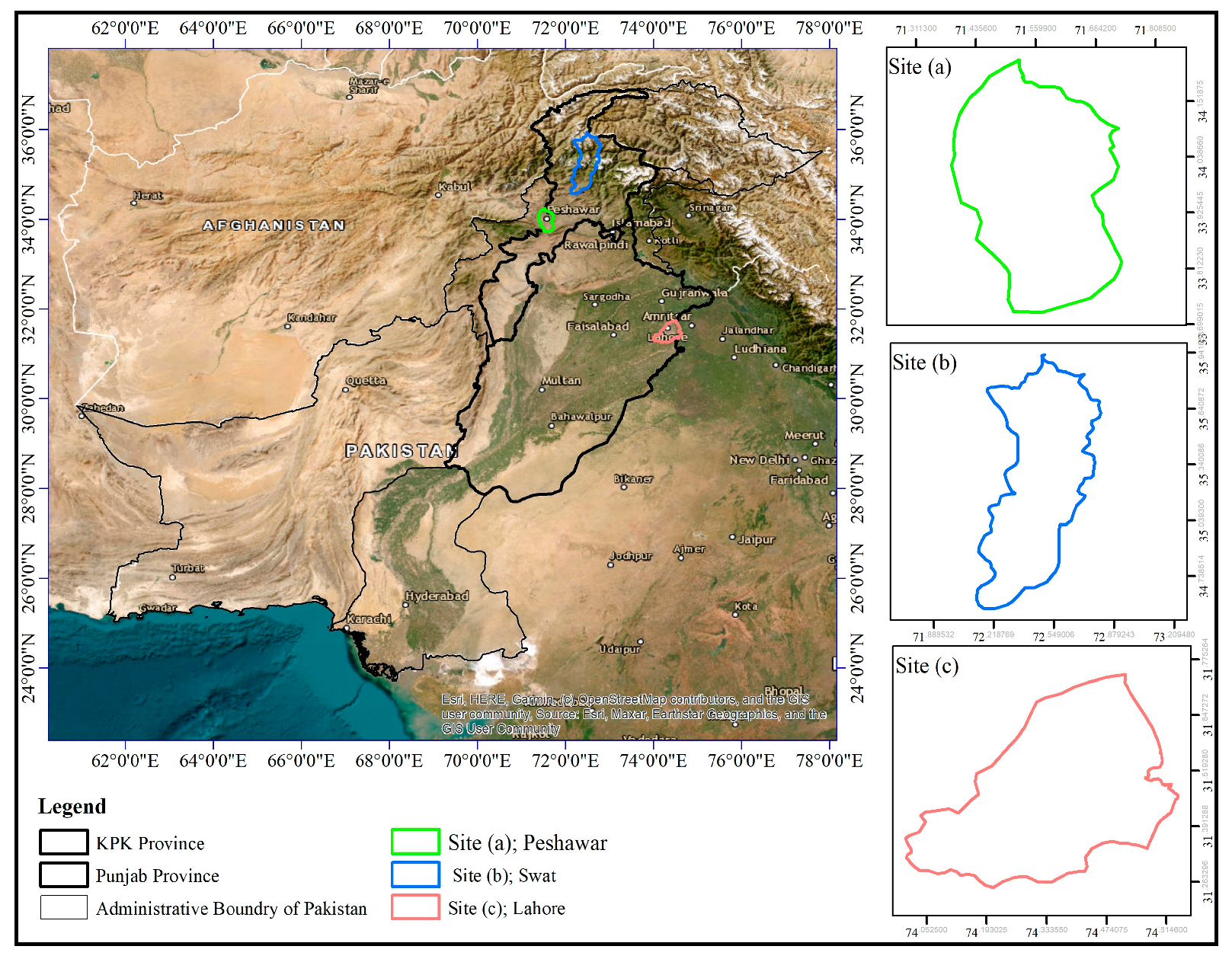

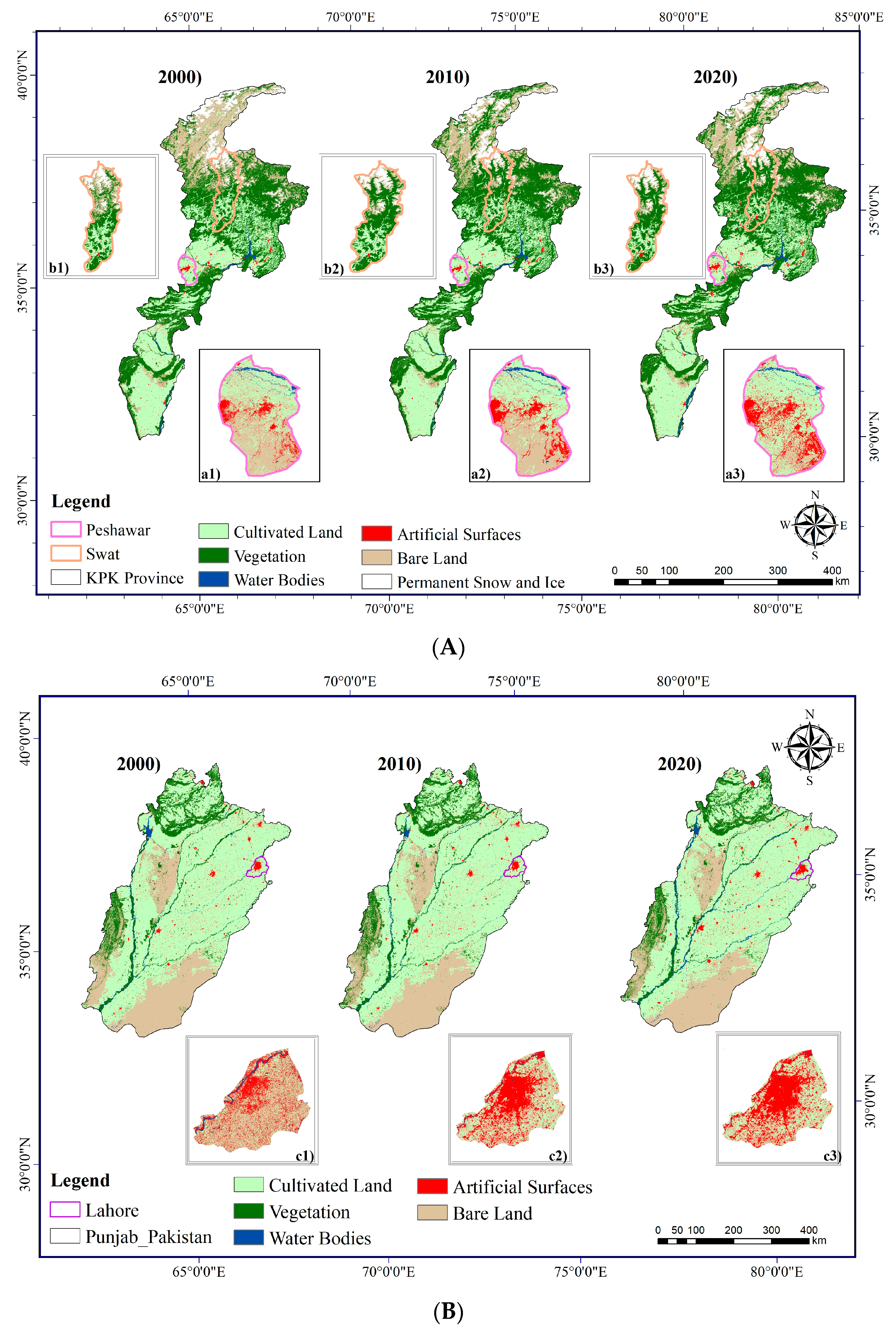
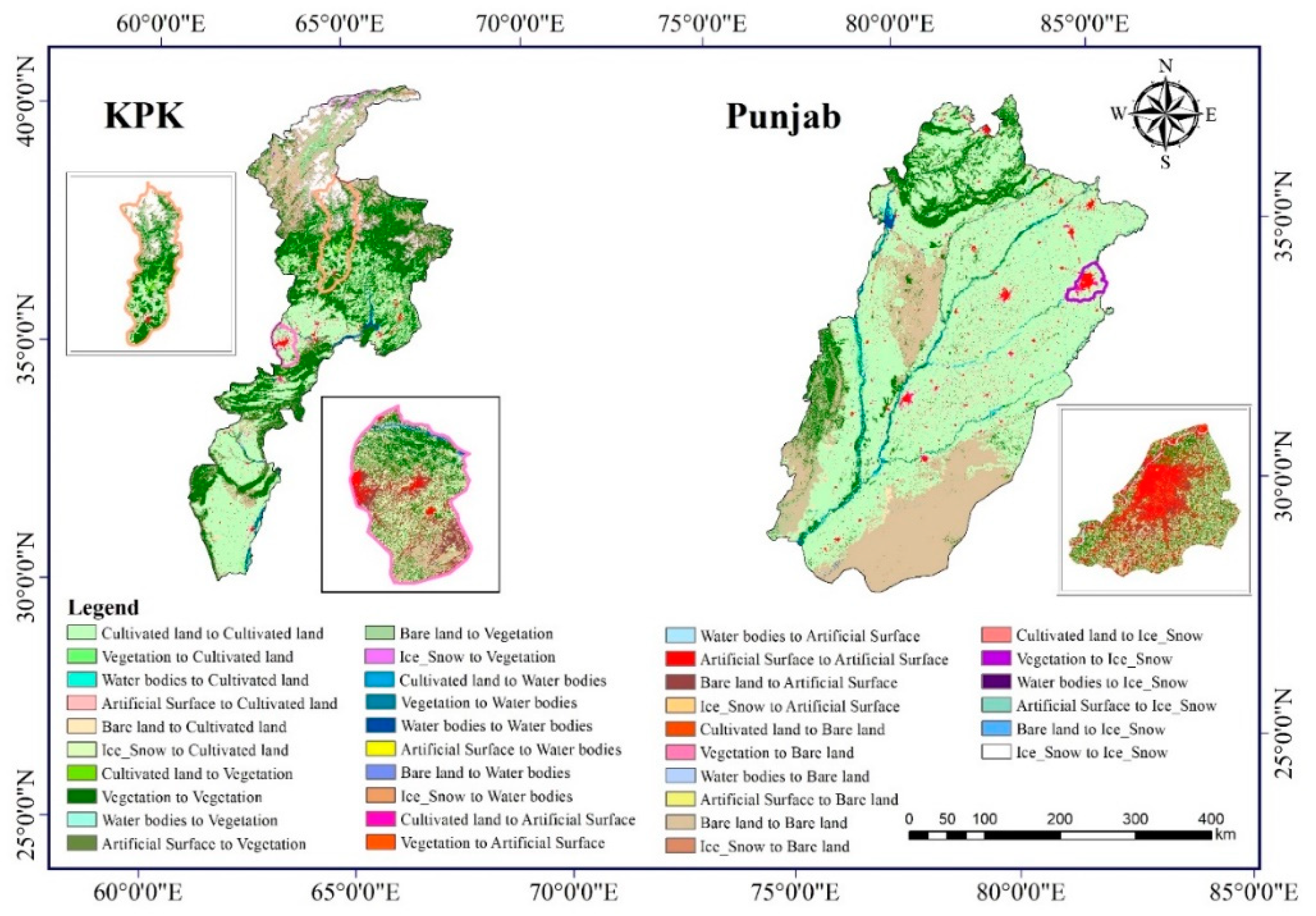
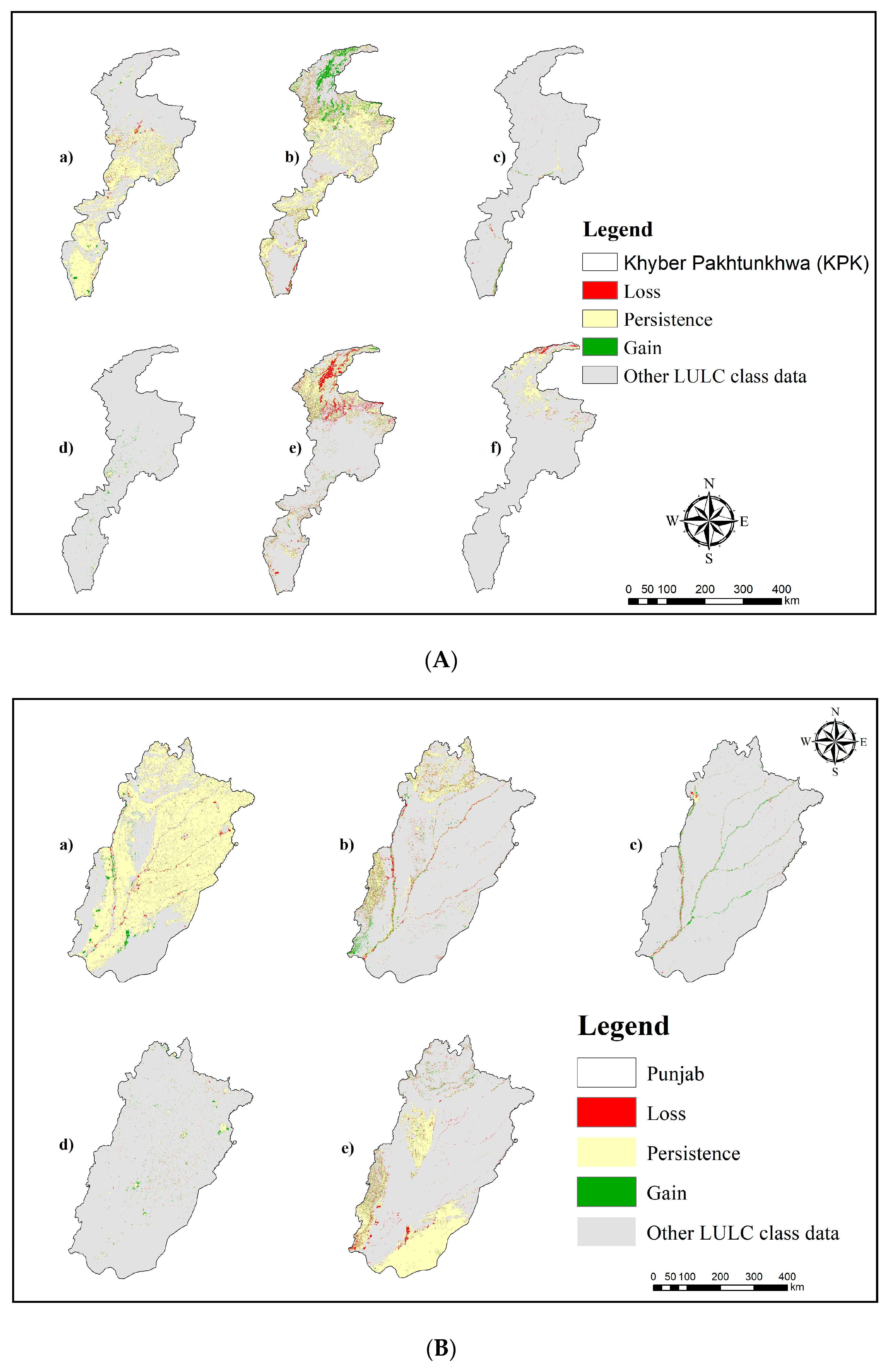
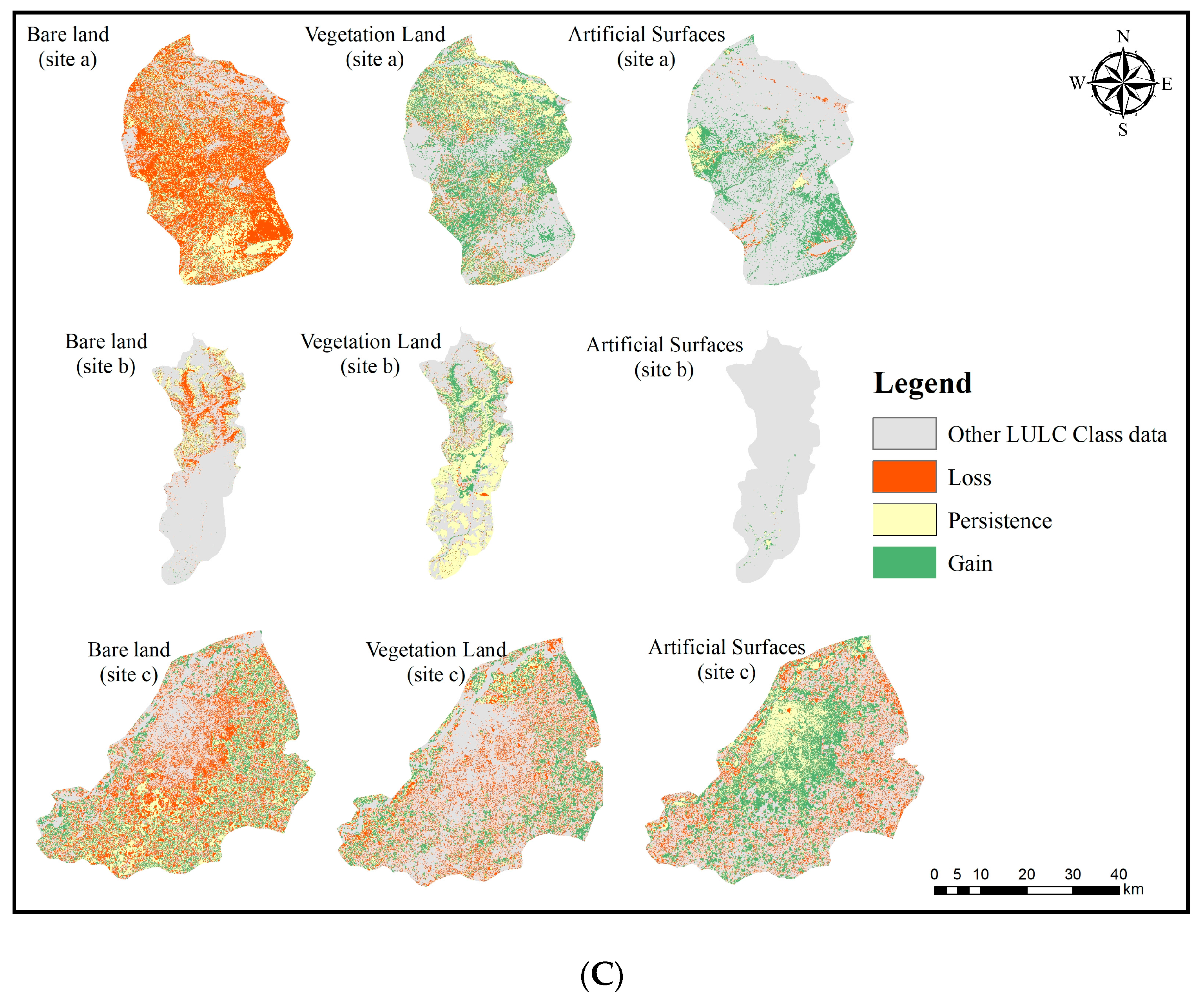
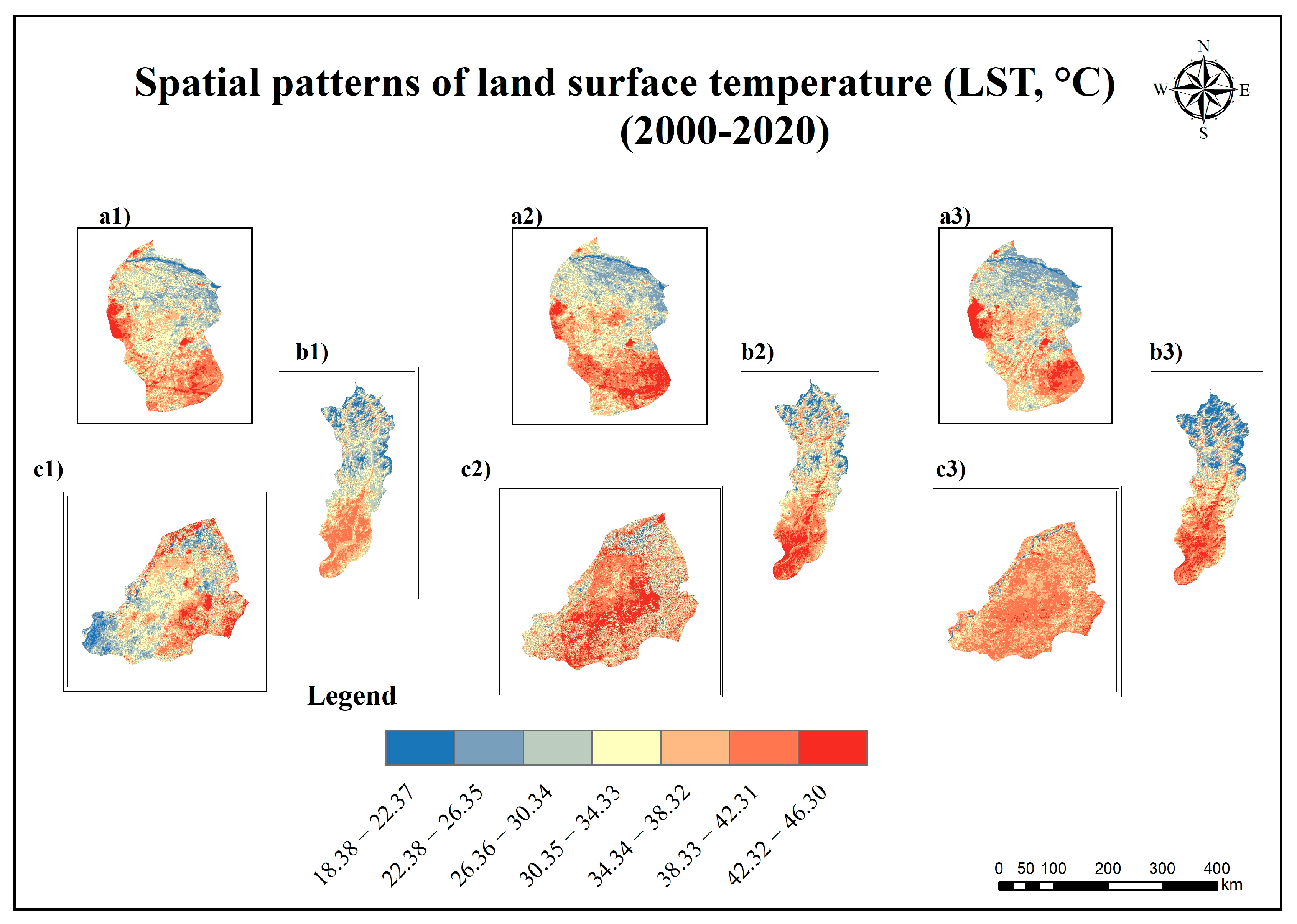

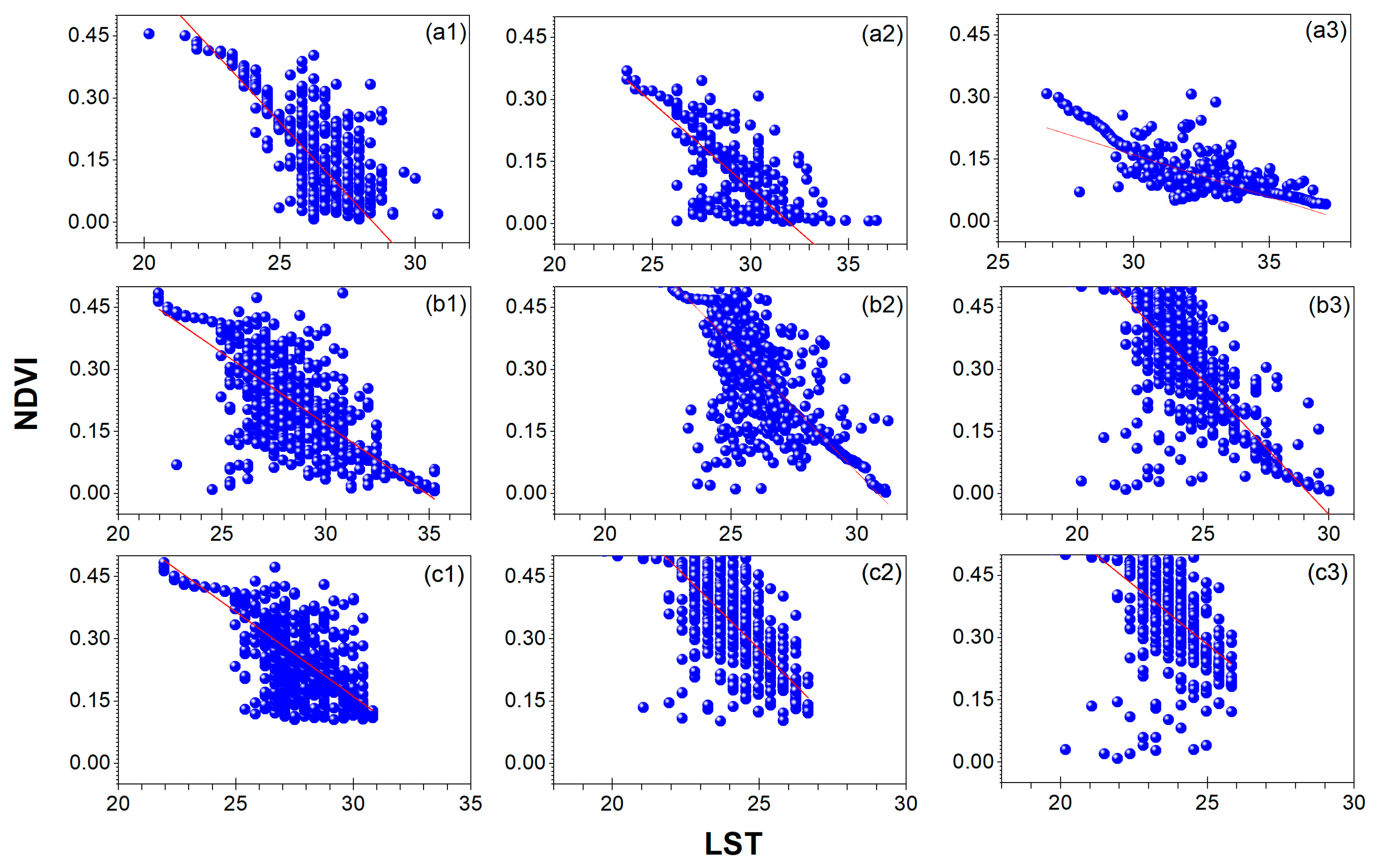
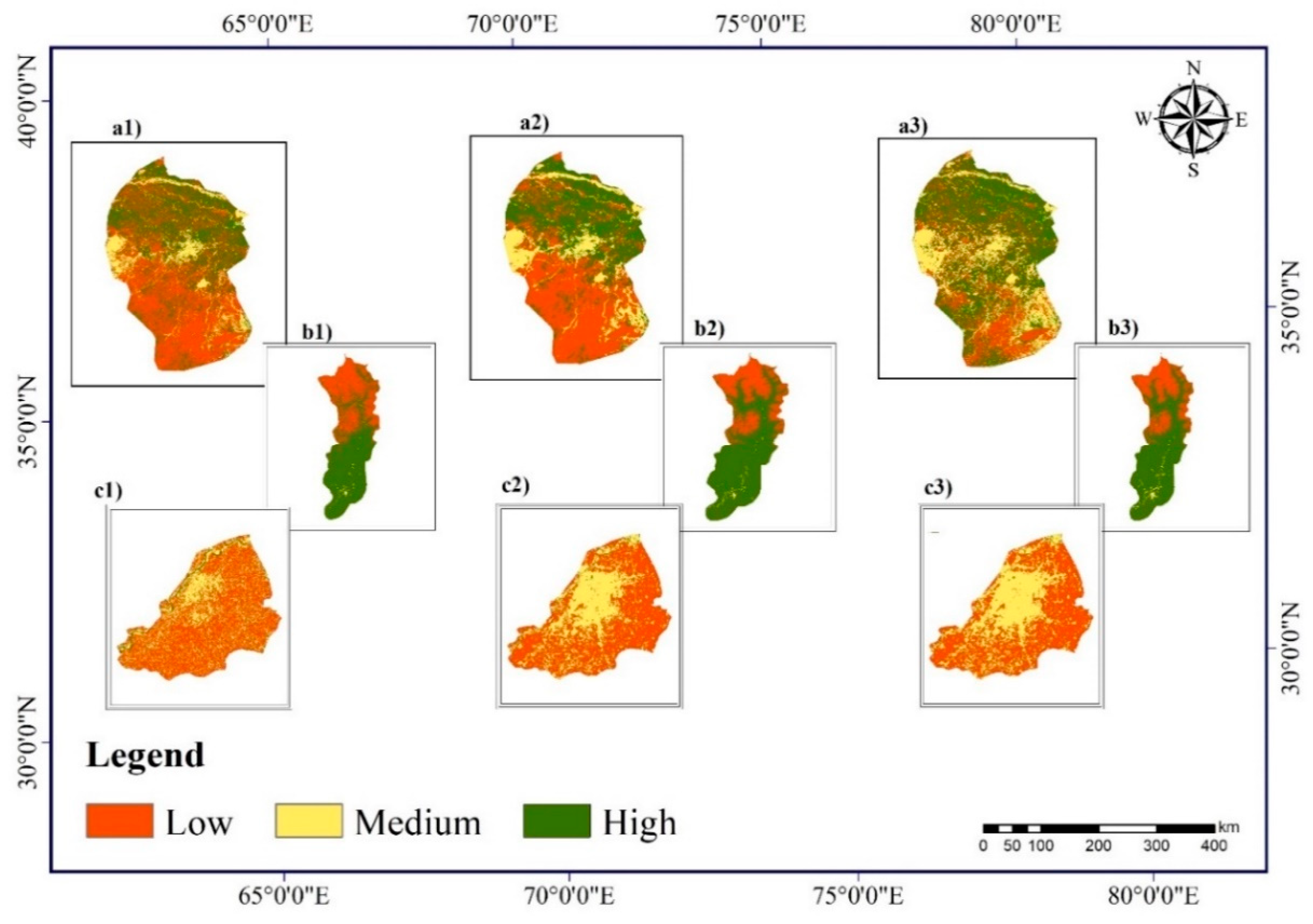
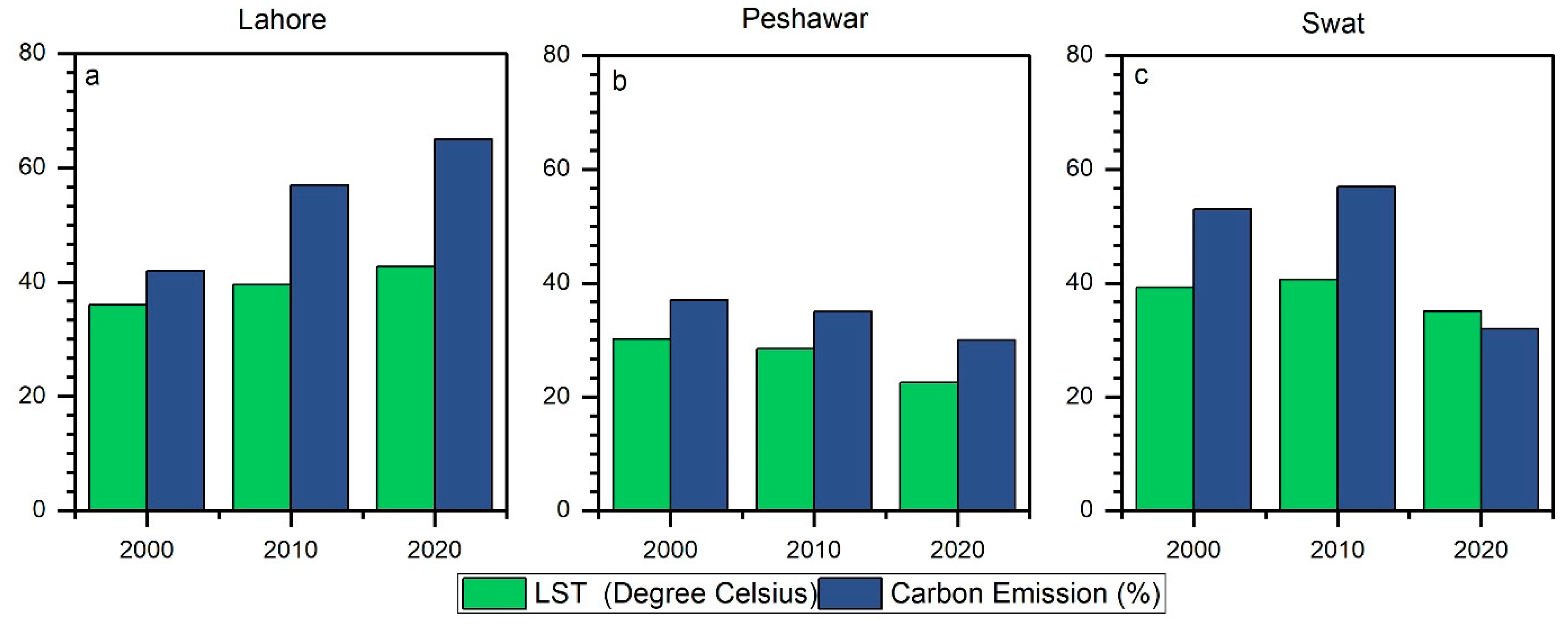
| Materials | Purpose |
|---|---|
| Diameter Caliper (120 cm) | Diameter Measurement |
| Haga Altimeter | Height Measurement |
| Sunnto Clinometer | Slope and Height Measurement |
| Measuring Tape (100 m) | Measuring Distance |
| Ranging Rods | Plot Center and Other Location |
| Garmin GPS | Navigation |
| Landsat Images | Computation of Vegetation Indices and Carbon Stock Assessment |
| 2000 | % | 2010 | % | 2020 | % | ||
|---|---|---|---|---|---|---|---|
| KPK | Cultivated land | 25,956.87 | 33.71 | 25,714.37 | 33.39 | 25,781.15 | 33.48 |
| Vegetation | 29,337.59 | 38.10 | 30,257.76 | 39.29 | 33,458.05 | 43.45 | |
| Water bodies | 727.82 | 0.95 | 842.2 | 1.09 | 695.58 | 0.90 | |
| Artificial surface | 664.18 | 0.86 | 1196.17 | 1.55 | 1375.82 | 1.79 | |
| Bare land | 14,598.18 | 18.96 | 13,285.62 | 17.25 | 10,346.19 | 13.44 | |
| Ice and snow | 5724.44 | 7.43 | 5712.96 | 7.42 | 5352.29 | 6.95 | |
| Total | 77,009.08 | 100 | 77,009.08 | 100 | 77,009.08 | 100 | |
| Punjab | Cultivated land | 136,014.21 | 64.91 | 137,125.65 | 65.44 | 137,244.7 | 65.50 |
| Vegetation | 21,250.54 | 10.14 | 21,303.2 | 10.17 | 19,634.2 | 9.37 | |
| Water surface | 2459.14 | 1.17 | 2325.64 | 1.11 | 2240.43 | 1.07 | |
| Artificial surface | 3846.3 | 1.84 | 4065.38 | 1.94 | 6497.6 | 3.10 | |
| Bare land | 45,960.09 | 21.93 | 44,710.43 | 21.34 | 43,913.37 | 20.96 | |
| Total | 209,530.30 | 100 | 209,530.30 | 100 | 209,530.30 | 100 |
| Cultivated Land | Vegetation | Water Bodies | Artificial Surfaces | Bare Land | Permanent Snow and Ice | ||
|---|---|---|---|---|---|---|---|
| KPK | Cultivated land | 24,674.29 | 705 | 72.94 | 466.51 | 38.07 | NA |
| Vegetation | 685.04 | 26,541.1 | 198.82 | 33.79 | 1711.54 | 167.24 | |
| Water bodies | 57.02 | 108.02 | 508.49 | 1.42 | 51.35 | 1.5 | |
| Artificial surfaces | 66.92 | 6.71 | 0.72 | 589.22 | 0.59 | NA | |
| Bare land | 231.05 | 4375.87 | 60.97 | 5.21 | 9750.15 | 174.9 | |
| Permanent snow and ice | NA | 520.97 | 0.22 | NA | 233.89 | 4969.31 | |
| Punjab | Cultivated land | 13,2359.4 | 698.7 | 1072.7 | 1619.9 | 256.0 | NA |
| Vegetation | 1067.0 | 16,655.6 | 1187.0 | 1074.9 | 2263.5 | NA | |
| Water bodies | 422.7 | 626.0 | 1332.3 | 4.2 | 73.6 | NA | |
| Artificial surfaces | 584.1 | 14.1 | 5.7 | 3227.0 | 15.3 | NA | |
| Bare Land | 1211.3 | 58.7 | 242.3 | 1840.3 | 41,605.0 | NA |
| Peshawar | Equation | y = a + b × x | y = a + b × x | y = a + b × x |
| Plot | NDVI 2000 | NDVI 2010 | NDVI 2020 | |
| Weight | No Weighting | No Weighting | No Weighting | |
| Intercept | 1.20 ± 0.01 | 1.92479 ± 0.02 | 1.89 ± 0.02 | |
| Slope | −0.03 ± 4.24 | −0.06 ± 0.00 | −0.06 ± 8.20 | |
| Residual sum of squares | 4.74 | 5.56 | 6.27 | |
| Pearson’s r | −0.88 | −0.83 | −0.89 | |
| R2 (COD)/ | 0.78 | 0.70 | 0.80 | |
| Swat | Equation | y = a + b × x | y = a + b × x | y = a + b × x |
| Plot | NDVI 2000 | NDVI 2010 | NDVI 2020 | |
| Weight | No Weighting | No Weighting | No Weighting | |
| Intercept | 1.38 ± 0.02 | 2.02 ± 0.03 | 1.70 ± 0.04 | |
| Slope | −0.04 ± 9.85 | −0.06 ± 0.00 | −0.05 ± 0.00 | |
| Residual sum of squares | 2.88 | 3.80 | 4.43 | |
| Pearson’s r | −0.78 | −0.83 | −0.68 | |
| R2 (COD) | 0.58 | 0.61 | 0.69 | |
| Lahore | Equation | y = a + b × x | y = a + b × x | y = a + b × x |
| Plot | NDVI 2000 | NDVI 2010 | NDVI 2020 | |
| Weight | No Weighting | No Weighting | No Weighting | |
| Intercept | 1.99 ± 0.02 | 1.32 ± 0.02 | 0.77 ± 0.01 | |
| Slope | −0.07 ± 8.53 | −0.04 ± 8.42 | −0.02 ± 3.32 | |
| Residual sum of squares | 3.35 | 1.66 | 0.75 | |
| Pearson’s r | −0.89 | −0.84 | −0.84 | |
| R2 (COD) | 0.83 | 0.72 | 0.59 |
| Cultivated Land | Vegetation | Water Bodies | Artificial Surfaces | Bare Land | Permanent Snow and Ice | ||
|---|---|---|---|---|---|---|---|
| Peshawar | Cultivated land | −0.01 | −0.05 | 0.07 | 0.11 | 0.16 | NA |
| Vegetation | 0.03 | −0.01 | 0.06 | 0.18 | 0.13 | −0.1 | |
| Water bodies | −0.2 | −0.13 | 0.01 | 0.14 | 0.17 | 0.1 | |
| Artificial surfaces | −0.18 | −0.15 | −0.1 | 0.01 | 0.09 | NA | |
| Bare land | −0.08 | −0.24 | −0.1 | 0.12 | 0.01 | −0.14 | |
| Swat | Cultivated land | −0.02 | −0.04 | 0.05 | 0.09 | 0.14 | −0.01 |
| Vegetation | 0.02 | −0.02 | 0.04 | 0.13 | 0.16 | −0.03 | |
| Water bodies | 0.1 | 0.06 | 0.02 | 0.1 | 0.15 | −0.1 | |
| Artificial surfaces | −0.12 | 0.16 | −0.2 | 0 | 0.1 | −0.09 | |
| Bare land | −0.05 | −0.19 | −0.02 | 0.14 | 0 | −0.17 | |
| Lahore | Cultivated land | −0.01 | −0.03 | 0.1 | 0.13 | 0.14 | NA |
| Vegetation | 0.02 | −0.01 | −0.09 | 0.17 | 0.16 | NA | |
| Water | −0.02 | 0.06 | 0.1 | 0.13 | 0.14 | NA | |
| Artificial surfaces | −0.19 | −0.21 | −0.11 | 0.19 | 0.17 | NA | |
| Bare land | −0.22 | −0.18 | −0.01 | 0.16 | 0.06 | NA |
Disclaimer/Publisher’s Note: The statements, opinions and data contained in all publications are solely those of the individual author(s) and contributor(s) and not of MDPI and/or the editor(s). MDPI and/or the editor(s) disclaim responsibility for any injury to people or property resulting from any ideas, methods, instructions or products referred to in the content. |
© 2023 by the authors. Licensee MDPI, Basel, Switzerland. This article is an open access article distributed under the terms and conditions of the Creative Commons Attribution (CC BY) license (https://creativecommons.org/licenses/by/4.0/).
Share and Cite
Mumtaz, F.; Li, J.; Liu, Q.; Tariq, A.; Arshad, A.; Dong, Y.; Zhao, J.; Bashir, B.; Zhang, H.; Gu, C.; et al. Impacts of Green Fraction Changes on Surface Temperature and Carbon Emissions: Comparison under Forestation and Urbanization Reshaping Scenarios. Remote Sens. 2023, 15, 859. https://doi.org/10.3390/rs15030859
Mumtaz F, Li J, Liu Q, Tariq A, Arshad A, Dong Y, Zhao J, Bashir B, Zhang H, Gu C, et al. Impacts of Green Fraction Changes on Surface Temperature and Carbon Emissions: Comparison under Forestation and Urbanization Reshaping Scenarios. Remote Sensing. 2023; 15(3):859. https://doi.org/10.3390/rs15030859
Chicago/Turabian StyleMumtaz, Faisal, Jing Li, Qinhuo Liu, Aqil Tariq, Arfan Arshad, Yadong Dong, Jing Zhao, Barjeece Bashir, Hu Zhang, Chenpeng Gu, and et al. 2023. "Impacts of Green Fraction Changes on Surface Temperature and Carbon Emissions: Comparison under Forestation and Urbanization Reshaping Scenarios" Remote Sensing 15, no. 3: 859. https://doi.org/10.3390/rs15030859
APA StyleMumtaz, F., Li, J., Liu, Q., Tariq, A., Arshad, A., Dong, Y., Zhao, J., Bashir, B., Zhang, H., Gu, C., & Liu, C. (2023). Impacts of Green Fraction Changes on Surface Temperature and Carbon Emissions: Comparison under Forestation and Urbanization Reshaping Scenarios. Remote Sensing, 15(3), 859. https://doi.org/10.3390/rs15030859












